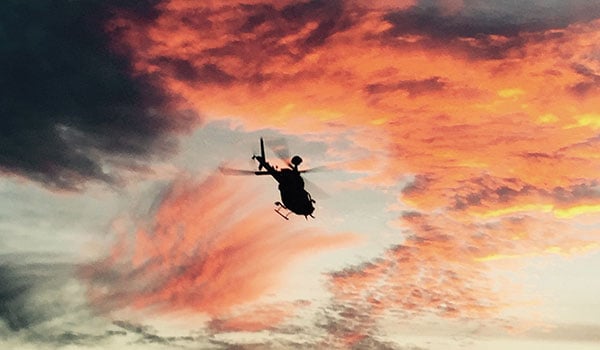
PEO Aviation / By BG Robert L. Marion: Without question, Aviation is recognized as a critical enabler and maneuver capability when executing effective combined arms operations across the full spectrum of operations. In a similar vein, Equipping is recognized as one of the Army’s four pillars of readiness, and a critical enabler of the Army’s number one priority. Where some might see modernization and readiness as competitors in a resource constrained environment, it is more important to understand how modernization and readiness go hand-in-hand. Our ongoing modernization efforts guarantee that our Soldiers are best equipped and ready to defeat hybrid forces and near-peer threats in all environments. Inherently reliable and sustainable designs ensure our aircraft are ready when called upon. As we continue ongoing fielding of improvements to aircraft and aviation support equipment, we are also looking to the future.

An OH-58D Kiowa Warrior assigned to C Troop, 1-230th Air Cavalry Squadron, Tennessee Army National Guard, at Ft. Sill, OK, November 10, 2015. / PHOTO BY CW2 CALEB J. BUCY
Our maturing Science and Technology (S&T) efforts are focused on increasing the capability of our systems in the areas that matter the most; survivability, range, payload, endurance, reliability, and lethality. In addition, programs like the Brownout Rotorcraft Enhancement System (BORES) and the Improved Turbine Engine (ITE) will significantly improve the capability of our current fleet, and will leverage emerging technology to achieve gains in performance for our next generation aircraft. The result will be safer, more capable, and more efficient aircraft. These are materiel investments that will manifest themselves in increased readiness.
Even as we face a reduction in modernization dollars in the President’s Budget for fiscal year 2017 (FY17), aviation continues to be a high priority. Of the funds allocated to modernization, Aviation remains the largest portfolio. With the associated reduction in procurement funding, it is critical to maintain the integrity of production contracts for Apache, Black Hawk, and Chinook aircraft. We are challenged to continue achieving maximum efficiency with our procurement funds, and have also worked with industry and other partner nations to leverage Foreign Military Sales (FMS) to maintain stable production quantities.
Within the PEO Aviation workforce, we will continue to focus on executing programs to plan. To be successful, teamwork from our multiple partners within the Aviation Enterprise, to include the Aviation and Missile Command (AMCOM), Aviation and Missile Research, Development, and Engineering Center (AMRDEC), Army Test and Evaluation Command, (ATEC), Army Contracting Command – Redstone Arsenal (ACC-R), Training and Doctrine Command (TRADOC), and our sister program executive offices (PEOs) is a necessity. The Defense Acquisition Executive’s (DAE’s) recent delegation of Milestone Decision Authority (MDA) to the Army for the CH-47 Block II and Improved Turbine Engine (ITE) programs is a testament to the confidence our senior leaders have in how the Aviation Enterprise executes its mission, and in our performance as stewards of treasured resources.
Modernization Across the Portfolio
We have witnessed significant progress across our modernization programs this year, with several systems achieving major milestones, and others delivering new capability to our supported customers.
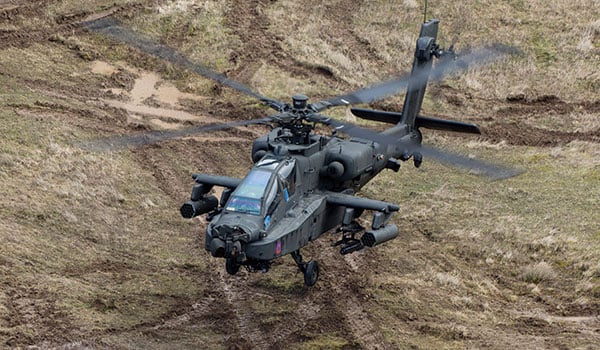
An AH-64E Guardian from 1st Bn. (Attack/Recon), 3rd Avn. Regt., 12th Cbt. Avn. Bde. at Hohenfels, Germany during Allied Spirit IV exercise Jan. 27, 2016 / U.S. ARMY PHOTO 1-3RD ARB
Apache
By the time this article is published, the Apache Project Office will have fielded the first Version 4 (V4) AH-64E from the Apache Remanufacture Production line to 7-17th CAV at Fort Hood, TX. The E model program incorporates two planned technology insertions in order to provide the full capability required by the Army.
The AH-64E V4 is the first technology insertion into the Apache Guardian production line. This modification adds a second Ethernet Routing Device (ERD), Enhanced Solid State Recording Device (eSSRD), Air-to-Air-to-Ground Video Relay (AAG), Blue Force Tracker 2 (BFT2), Link 16 Small Tactical Terminal, Reduced size Crashworthy External Fuel System (RCEFS), and Improved Fire Detection. In addition, the Version 4 Software upgrade integrates the first channel of the Small Tactical Terminal (STT) radio, enabling Link 16. Link 16 is a military tactical data exchange that provides a standardized communications link for the transmission of digital information. Link 16 is used by all branches of the military as well as 30+ NATO and Coalition Nations.
In parallel with delivery of V4 aircraft from the production line, the Apache Production and Fielding Modifications Team will retrofit aircraft to the V4 configuration on-site at fielded AH-64E battalions and the Fort Rucker training base. Aircraft will be modified two at a time to minimize the impact to aircraft availability. The retrofit modifications are currently planned to begin in early 2017.
The second technology insertion, Version 6, will enable the Soldier Radio Waveform (SRW) on the second channel of the STT radio. SRW is an internet protocol (IP)-based waveform that provides local area connectivity for small combat units and supports networking between mounted and dismounted soldiers. This Line of Sight, Mobile Ad-hoc Networking Waveform provides automatic network forming, merging, and re-routing capabilities which are all transparent to the user. These features facilitate transmission of information across large distances and elevated terrain.
The Apache Remanufacture Production Line will continue delivering V4 capable aircraft until FY19 (Lot 9) when the transition to Version 6 (V6) capability occurs. V6 will also include Radar Frequency Interferometer (RFI) range improvements, Fire Control Radar (FCR) improvements, SRW, and the Integrated Maintenance Support System. Version 6 will begin fielding in FY19.
Black Hawk
The UH-60V program achieved several milestones during FY15. The UH-60V will digitize 760 UH-60L aircraft and is timed to coincide with the airframe recapitalization at Corpus Christi Army Depot. The UH-60V program is a great example of how the aviation enterprise can deliver capability to our Army during periods of declining resources. The program’s Integrated Baseline Review (IBR) was held in February and the Preliminary Design Review (PDR) was conducted in April. Following the successful completion of the Critical Design Review (CDR) in October, A-kit/B-kit development began. Currently, three prototypes are being built to confirm our designs. After design confirmation, a fourth validation aircraft and fifth verification aircraft will support our ability to continue moving forward with the program. First flight for the UH-60V is scheduled for January 2017. The program remains on schedule to reach a Milestone C decision in 2018.
In parallel, the Utility Helicopter Project Office is aggressively improving the UH-60M’s Communication, Navigation, and Surveillance/Air Traffic Management (CNS/ATM) systems to meet current and future requirements. Upgrades to CNS/ATM include Automatic Dependent Surveillance-Broadcast Out (ADS-B Out) and Area Navigation (RNAV). In addition, upgrades to Integrated Vehicle Health Management System (IVHMS) and the Ground Station will improve and enhance data retrieval, storage, and diagnostic capabilities. Also, an updated Data Transfer System (DTS) will provide a significant increase in storage capacity. The UH-60M with CNS/ATM upgrades will begin fielding in FY18 to meet worldwide navigation requirements.
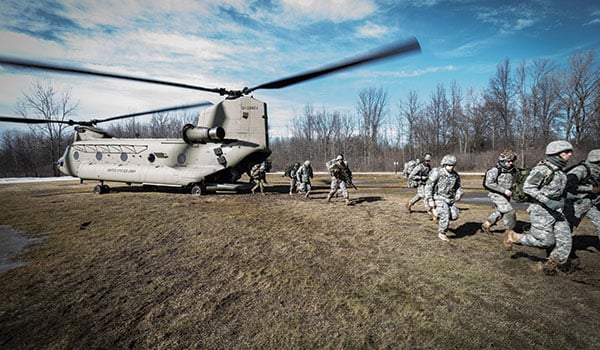
Soldiers from C Troop, 2-101 Cavalry, from Buffalo, simulate being inserted at a landing zone from a U.S. Army CH-47 Chinook helicopter, Youngstown, NY, Feb. 20, 2016. / U.S. AIR NATIONAL GUARD PHOTO BY SSGT. RYAN CAMPBELL
Chinook
As the Army’s only heavy-lift cargo helicopter, the CH-47 Chinook will remain in service until the 2060s. To support this requirement, the Cargo Helicopter Project Office has developed a blocking strategy designed to insert incremental technology upgrades into the fleet that will maintain the platform’s relevance and affordability over time while meeting operational demands. In January 2016, the Army granted approval for the release of a sole source Request for Proposal (RFP) to support the first increment of this strategy, the CH-47 Block II. We anticipate awarding the subsequent Engineering, Manufacturing, and Development (EMD) contract in mid-2017, contingent upon Milestone B approval of the Block II. The Block II effort seeks to buy-back performance that has eroded since CH-47F system fielding in 2007 due to the addition of mission equipment. Block II implements targeted engineering changes that increase system performance (rotor blade, rotor hub, drive train, fuel system), reduce sub-system weight (fuel system), and increases the system gross weight from 50,000 to 54,000 pounds (airframe). Additional engineering changes included in Block II target reliability, obsolescence, safety, and maintainability.
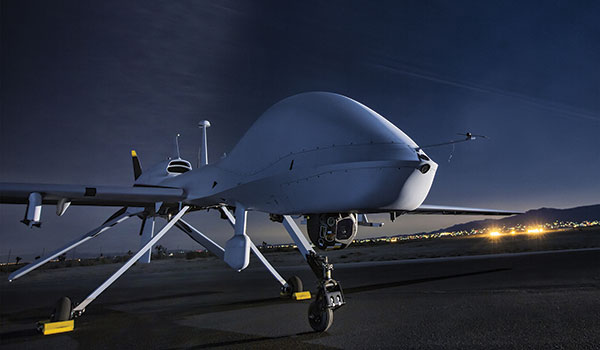
MQ-1C Gray Eagle at the General Atomics flight test facility, El Mirage, CA./ GENERAL ATOMICS
Unmanned Aircraft Systems
The MQ-1C Improved Gray Eagle (IGE) aircraft is the next-generation derivative of the baseline MQ-1C Gray Eagle. The IGE supports Combatant Commanders’ requirements to have increased range, endurance, and payload. It also provides the additional operational reach to support missions at extended distances beyond the capability of Divisional UAS. These systems will support Echelon Above Division (EAD) units including the U.S. Army’s Intelligence and Security Command’s Military Intelligence Brigade as well as the US Army Special Operation Command’s 160th Special Operations Aviation Regiment. Production of the IGE was initiated this year following Army Acquisition Executive (AAE) approval of the Configuration Steering Board (CSB) on 14 July 2015. An IGE Engineering Change Proposal was awarded on 22 September 2015 to produce, test, and deliver 36 IGE aircraft. The IGE is scheduled to begin fielding in FY18.
Fixed Wing
During the past year, the Fixed Wing Project Office made significant progress in the execution of two intelligence, surveillance, and reconnaissance (ISR) programs: Enhanced Medium Altitude Reconnaissance and Surveillance System (EMARSS) and Airborne Reconnaissance Low (ARL). The replacement program for fixed wing transport aircraft, the Fixed Wing Utility Aircraft (FUA), also gained momentum.
The EMARSS fleet of 24 aircraft consists of four variants, all based on the King Air 350 platform, and capitalizes on proven quick reaction capability (QRC) programs developed to meet the needs of combatant commanders in the field. These QRC aircraft are being modified into the EMARSS configuration, resulting in significant commonality in mission equipment, training, and supply chain. This increases the program’s efficiency, sustainability, and cost effectiveness. Three of the previously fielded QRC variants entered Initial Variant Modifications with contract awards in 2QFY15 followed by successful Preliminary and Critical Design Reviews. The remaining variant, EMARSS-S, successfully completed Initial Key Personnel Training and Limited User Test at the U.S. Intelligence Center of Excellence at Fort Huachuca, AZ followed by New Equipment Training at the 224th Aerial Exploitation Battalion in Savannah, GA. EMARSS-S will deploy in March 2016.
The ARL program moved forward with a modernization strategy to replace, refresh, and upgrade the current DeHavilland Canada (DHC)-7 aircraft with more capable DHC-8-315, which are leveraged from existing QRC programs. The contracts for mission equipment package integration, cockpit and aircraft survivability equipment modification, and a long range radar were all awarded in 2015. Once the modifications are complete, the ARL fleet will total nine platforms.
In 2015, the Fixed Wing Utility Aircraft (FUA) Acquisition Strategy was approved, the Contracts Requirement Package entered staffing, and the draft Request for Proposal (RFP) was released to industry. The final FUA RFP is scheduled for release in 3QFY16 with Milestone C and procurement contract award expected in FY17. Successful completion of these administrative milestones draws us closer to delivery of this capability. When procured, the FUA will replace the Army’s C-12 and C-26 transport aircraft.
Future Vertical Lift and the Degraded Visual Environment
In May 2015 the Improved Turbine Engine/Future Vertical Lift (ITE/FVL) Project Office was established. The mission of the ITE and FVL programs is clear: revolutionize Army Aviation’s warfighting capability through innovative life cycle management of state of the art propulsion and vertical lift systems. Although these programs are in their early stages, the ITE/FVL team is ready for the opportunities ahead. For ITE, which was designated an ACAT 1C program on 23 June 2015, the first opportunity will be Milestone A, currently projected to occur in 3QFY16. Successful completion of Milestone A will support a contract award for preliminary design to two vendors in 4QFY16. The immediate opportunity for FVL, will be to execute the defined path to obtain a Materiel Development Decision in 1QFY17, and subsequently initiate the Analysis of Alternatives for the first FVL capability set.
JMR-TD
The Joint Multi-Role Technology Demonstrator (JMR-TD) is a key S&T effort that will inform the Future Vertical Lift (FVL) program. Through the development of two advanced air vehicle demonstrators, the JMR-TD will explore numerous technologies and an improved mission systems architecture. These demonstrators will represent the next-generation of aircraft with increased speed, range, payload, survivability, and showcase the ability to operate in all environments. The objective of the JMR-TD is to mature critical technologies to inform the FVL program of record, thereby reducing program risk. The first flight of the air vehicle demonstrators is anticipated in FY17.
DVE/BORES
Army Aviation has long “owned the night” with the use of night vision devices. Now the Army is focused on technology enabling its Aviators to “own the environment.” The DVE/Brownout Rotorcraft Enhancement Systems (BORES) program, managed by the Aviation Systems Project Office, is assessing Industry Technology Readiness Levels (TRLs) to define the path ahead to a cost-effective solution which integrates multi-sensor and geospatial data with symbology to enable approaches, landing, and takeoff in brownout conditions. DVE/BORES fielding is planned for select Utility and Cargo platforms, in advance of fielding throughout the rotary wing portfolio. Follow-on programs will address other DVE conditions such as whiteout, rain, and fog.
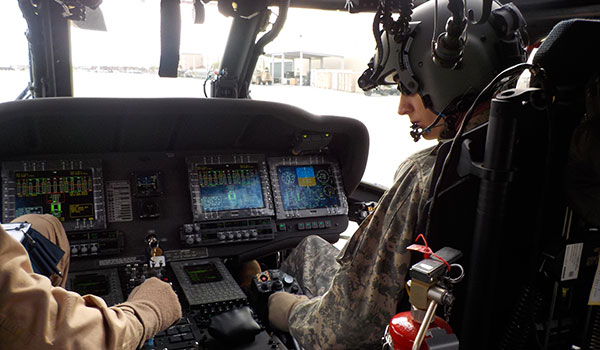
Cockpit of the UH-60M / PHOTO BY JOSEPH P. CREEKMORE, JR.
Supporting our Strategic Partners
The Non-Standard Rotary Wing Aircraft (NSRWA) Project Management Office (PMO) continues to execute programs in direct support of Combatant Commands and Partner Nations. In response to an urgent requirement from Afghanistan, NSRWA has procured, qualified, and is fielding 28 MD-530F close air support aircraft armed with rockets and machineguns. Another NSRWA effort is the AH-6i Scout/Light Attack helicopter program which consists of 24 Scout/Light Attack helicopters, spare parts, and initial transition training for both pilots and maintainers. These capabilities directly support the Combatant Commanders’ requirements and are a critical part of mission success in theater.
End of an Era
During the last year, the Armed Scout Helicopter (ASH) Project Directorate has focused on its final mission sets – divesting the Army’s remaining single-engine rotary wing platforms while continuing to provide safety-critical sustainment for the Army’s scout and training aircraft through the end of their divestment. The 2013 Aviation Restructure Initiative (ARI) called for the divestment of approximately 340 OH-58D Kiowa Warriors (KW) by FY17, and 215 OH-58A/Cs and 180 TH-67 training helicopters by FY19. The ASH Project Directorate is executing that task. To honor the retirement of the 45-year old KW, many cavalry units proudly flew their colors in commemorative final flights, as part of casing the colors ceremonies.
On the Horizon
As I look across the aviation fleet, we have never possessed a more technologically advanced and capable formation of systems, and the future only promises further improvement in capability. I believe resource constraints, although challenging, have caused us to become laser focused on the efforts that our enterprise has prioritized. We continue to foster a culture that values innovation and seeks continual improvement. The results are programs that are dialed in ready to execute. I am proud of what our enterprise is accomplishing, and humbled by the outstanding contributions made daily by our workforce and industry partners. We are truly doing our part to ensure the Equipping pillar stands firm in support of readiness.
BG Robert L. Marion is the U.S. Army Program Executive Officer, Aviation located at Redstone Arsenal, AL.








